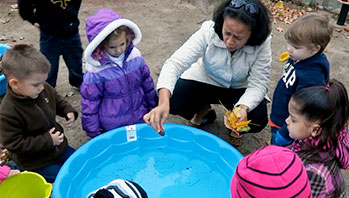- camera or cellphone (optional)
- clipboard
- markers
- paper
- sunglasses (child's; plastic)
- bright
- color
- darker
- different
- lighter
- same
Head Start Outcomes:
Science Knowledge/Scientific Skills and Method: Collects, describes, and records information through discussions, drawings, maps, and charts.
PreK Learning Guidelines:
Science and Technology/Inquiry Skills 3: Identify and use simple tools appropriately to extend observations.
English Language Arts/Language 2: Participate actively in discussions, listen to the ideas of others, and ask and answer relevant questions.
Science and Technology/Inquiry Skills 4: Record observations and share ideas through simple forms of representation such as drawings.
Science and Technology/Living Things and Their Environment 15: Use their senses of sight, hearing, touch, smell, and taste to explore their environment using sensory vocabulary.
Explore Together (outdoors): Shaded Colors

© Commonwealth of Massachusetts, Department of Early Education and Care. All rights reserved.
STEM Key Concepts: There are many different colors; A color can have many different shades (from very light to very dark); Objects appear to be a different color when viewed through a colored transparent material
ELA Focus Skills: Follow Directions, Speaking and Listening, Vocabulary
Safety Tips:
- Give children clear rules about the sunglasses and how to work together outside so everyone will be safe while exploring.
- Check areas for poison ivy, poison sumac, bushes with thorns before taking children outside.
- Remind children to wash their hands before and after the activity.
- Remind children not to eat ANY plants or touch any plants without asking an adult.
- Children’s allergies need to be taken into account before going outside.
Put on a pair of sunglasses and ask children if they have ever worn sunglasses before. Ask, Where did you wear sunglasses? Why did you wear them? Tell children that you are going to take them outdoors so they can explore how colors change when they put sunglasses on.
- Take children outside to an area that is full of bright colors, for example, a flower patch or a wall mural.
- Ask children to describe what they see. Encourage them to ask questions and use color vocabulary words to talk about the colors.
Have children focus one specific color/object and describe it. Then have them put on the sunglasses and ask them to describe the same color/object. Ask questions such as,
- Do the colors look the same or different? Turn to a buddy and describe how the colors look different.
- Does the color look lighter or darker with the sunglasses on? Why do you think so?
- Why do you think the color looks brighter when you have your sunglasses off?
Allow children to explore other areas/colors freely. Have them work with a partner and encourage them to record their observations by drawing or writing. As you circulate, you may want to use a camera or cellphone camera to record children's observations.
Reflect and Share Together
Once inside, have children share their experiences and what they observed while looking through the sunglasses. Have a pair of sunglasses available so children can demonstrate as they share. Share any pictures you took while children explored. Ask questions such as,
- Why do you think the colors looked darker when you put on the sunglasses?
- Did you notice any colors that looked the same with and without the sunglasses on? Why do you think that was?
- What do you think would happen if you wore the sunglasses at night when it is dark out?
Adaptation: For children who wear glasses already, try using dark-colored acetate paper to hold over children’s eyes to recreate the effect of wearing sunglasses.
Adaptation: If young children are in the group, you might need to give each child one-to-one supervision of putting on and removing the sunglasses.
Adaptation: For groups of children of varying ages, you may want to challenge older children by asking them to draw a picture of what a whole area looked like before and after they put on the sunglasses.
